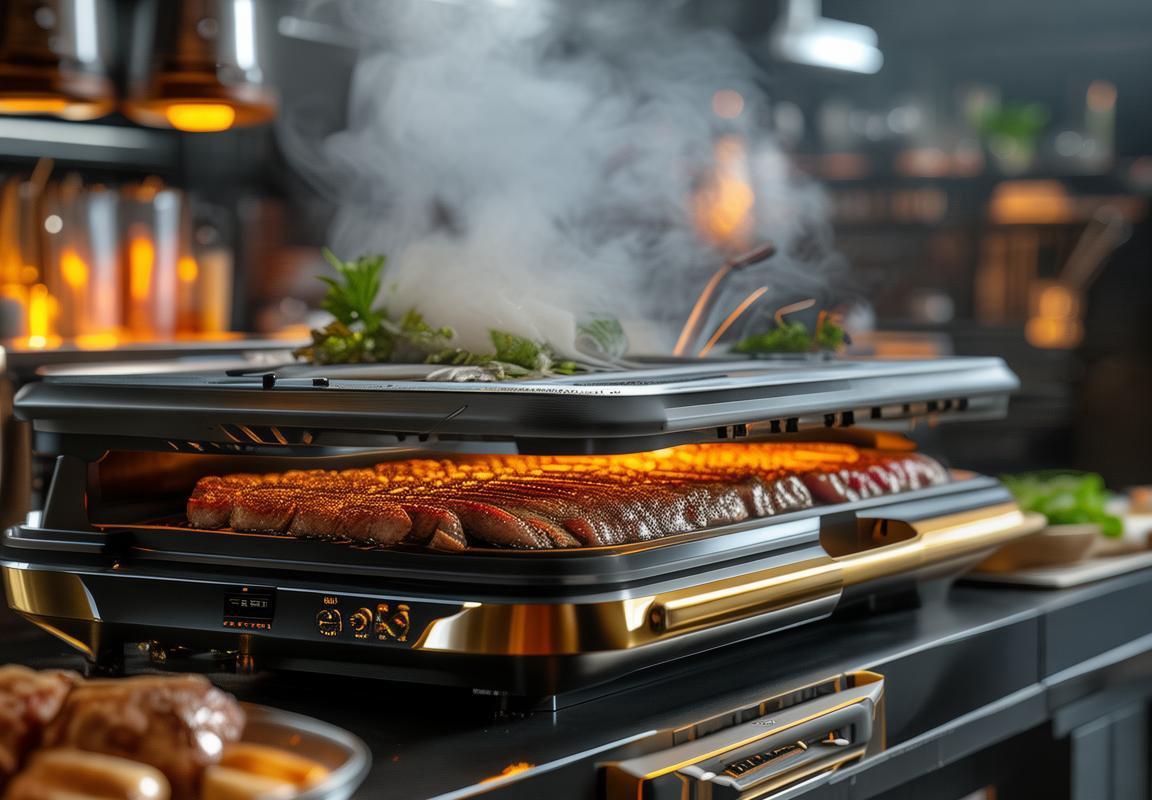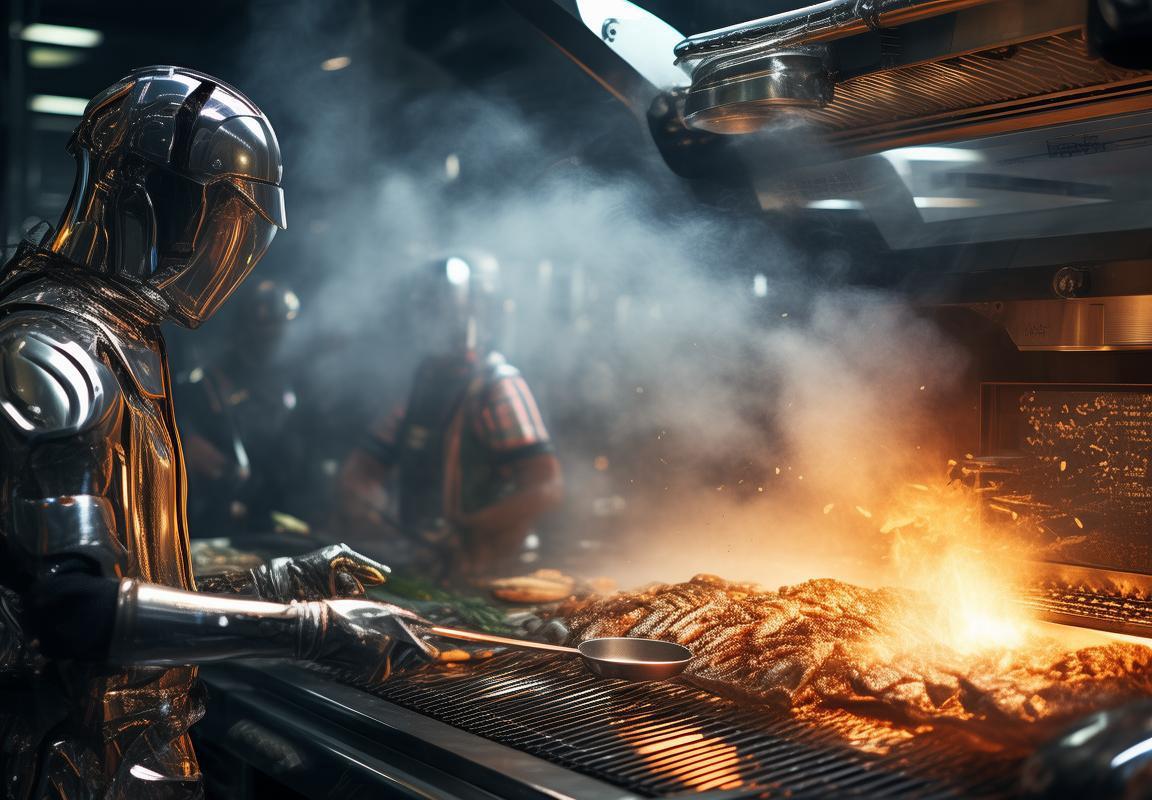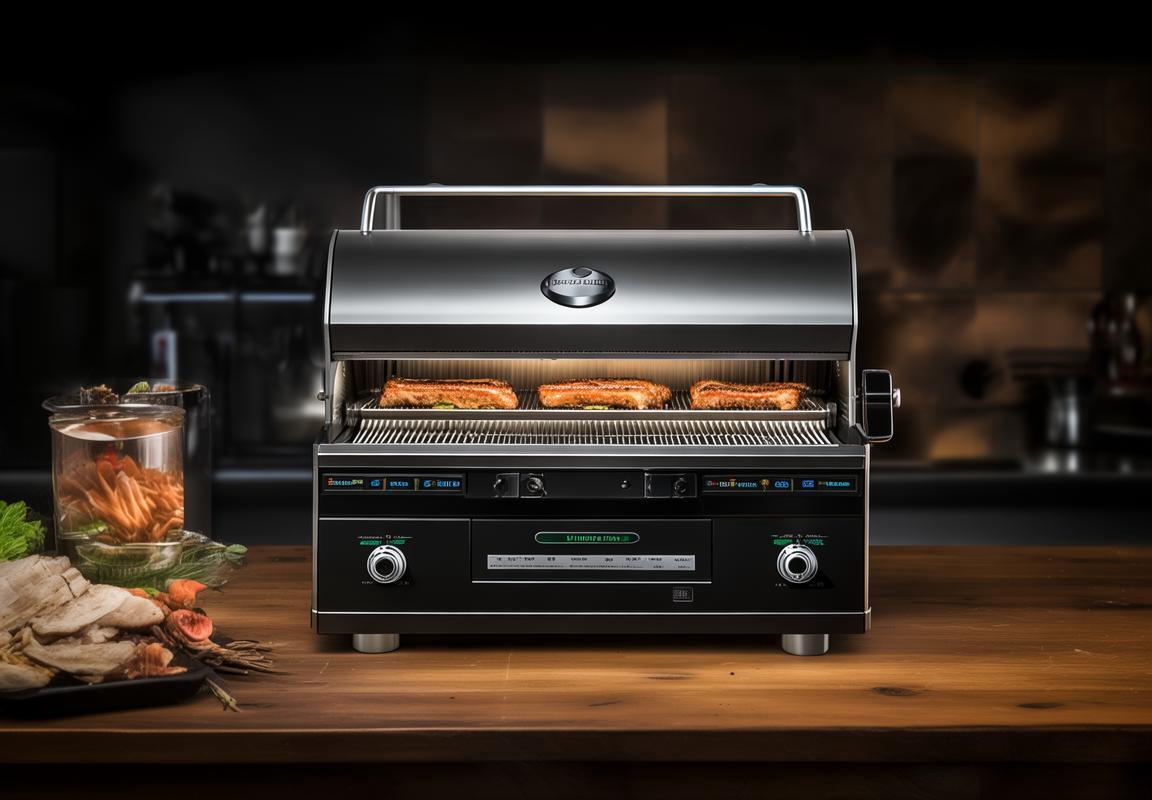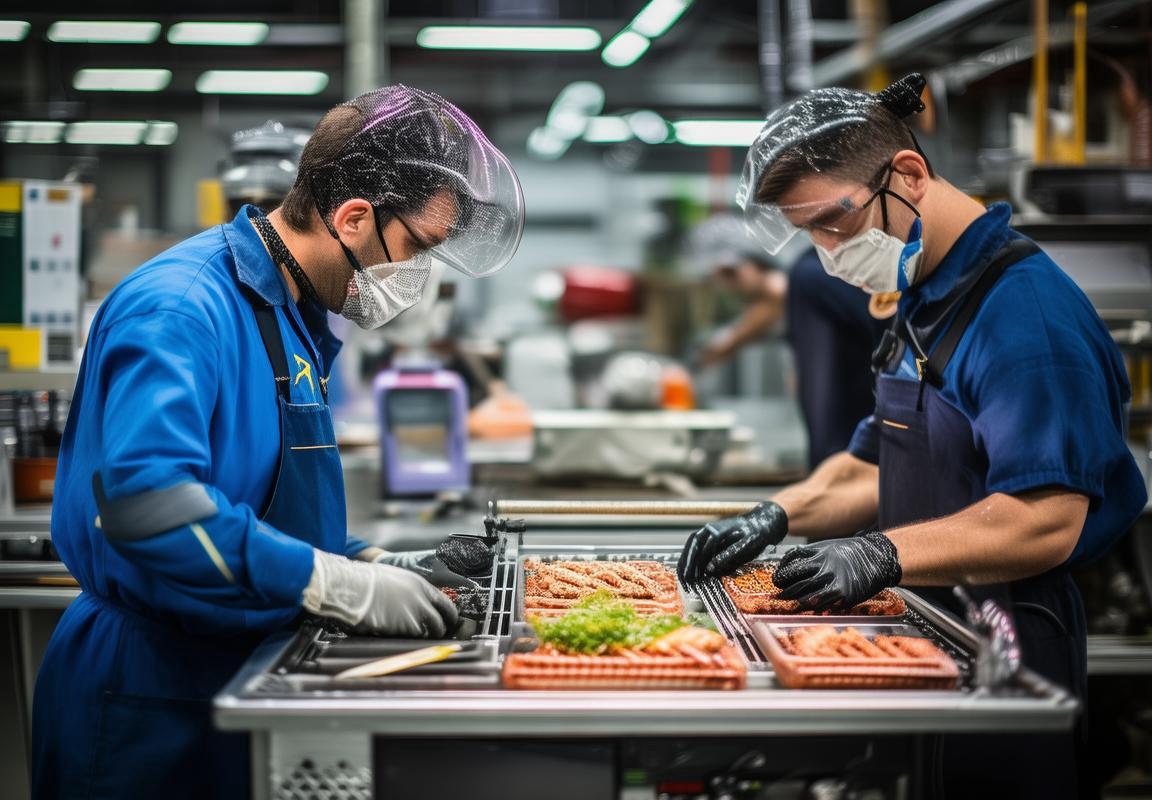In recent years, the culinary landscape has been revolutionized by the emergence of smokeless grills. These innovative cooking appliances have gained significant traction across various markets, particularly in Europe and the United States. As we delve into the factors shaping this trend, it becomes clear that a confluence of evolving consumer preferences, technological advancements, and regulatory changes is propelling the smokeless grill industry towards unprecedented growth.
Introduction to the Rise of Smokeless Grills
In recent years, the culinary landscape has undergone a significant transformation, with smokeless grills emerging as a game-changer in the commercial kitchen industry. These innovative appliances have revolutionized the way we cook outdoors, offering a healthier and more convenient alternative to traditional charcoal and wood-burning grills. This article delves into the reasons behind the rise of smokeless grills and their growing popularity in both Europe and the United States.
Smokeless grills, as the name suggests, eliminate the need for smoke by using advanced technology to achieve high-temperature cooking without the smoky residue typically associated with traditional grilling. This not only appeals to health-conscious consumers who are wary of the health risks posed by smoke but also to environmentally conscious individuals who seek to reduce emissions.
The shift towards smokeless grills is partly driven by a broader consumer preference for healthier cooking methods. With an increasing number of people suffering from respiratory issues and allergies, the elimination of smoke has become a major selling point. Moreover, smokeless grills offer a more controlled cooking environment, allowing chefs to achieve consistent results and precise temperature control.
In Europe, where sustainability and health are at the forefront of public discourse, the adoption of smokeless grills has been particularly swift. The European market has seen a surge in demand for these eco-friendly appliances, not only in commercial settings but also in residential ones. Chefs and homeowners alike are embracing the benefits of smokeless grills, which not only reduce the risk of fire but also minimize the cleanup process.
The United States, known for its love of outdoor cooking, has also experienced a considerable shift towards smokeless grilling. American consumers, who have traditionally been more inclined towards traditional grilling methods, are now increasingly turning to smokeless grills for their ease of use and efficiency. The American market has seen a diverse range of smokeless grill models catering to different preferences, from high-end commercial-grade units to compact residential models.
The technology behind smokeless grills has advanced significantly, allowing for more efficient and effective cooking. These grills often feature infrared heating elements that cook food quickly and evenly, resulting in delicious flavors without the need for smoke. The ability to maintain precise temperatures is particularly appealing to professional chefs who demand control over their cooking process.
Another factor contributing to the rise of smokeless grills is the culinary versatility they offer. These appliances can be used to cook a wide variety of foods, from meats and vegetables to seafood and even desserts. The ability to smoke, grill, and bake all in one device has made smokeless grills a must-have for many commercial kitchens and home cooks.
Despite the numerous benefits, the smokeless grill market is not without its challenges. One of the primary concerns is the initial cost, which can be higher than traditional grills. However, as technology advances and production scales up, prices are expected to become more accessible to a broader market.
In the European and American markets, leading brands are investing heavily in research and development to further improve the efficiency and performance of smokeless grills. This competition has led to a wide array of features, including built-in thermometers, Wi-Fi connectivity, and various cooking modes, making these grills highly adaptable to different types of food and cooking styles.
As the market continues to grow, the future of smokeless grills looks promising. The increasing awareness of health and environmental issues, combined with technological advancements, is expected to drive further adoption. Additionally, as consumers become more educated about the benefits of smokeless grilling, demand is likely to rise.
In conclusion, the rise of smokeless grills is a testament to the ongoing evolution of the culinary world. These innovative appliances offer a healthier, more convenient, and versatile cooking option that is gaining traction in both commercial and residential settings. With continued technological advancements and increased consumer awareness, smokeless grills are poised to become a staple in the kitchens of the future.

Understanding the Consumer Shift in Preferences
The landscape of consumer preferences has undergone a remarkable transformation, particularly in the realm of culinary appliances. This shift is most evident in the growing popularity of smokeless grills, which have captured the attention of both professional chefs and home cooks alike. As we delve into this trend, it becomes clear that several key factors are driving this change.
-
Health consciousness has become a cornerstone of modern consumer behavior. With an increasing awareness of the health risks associated with traditional smoking methods, such as the presence of carcinogens and the potential for respiratory issues, consumers are seeking alternative cooking methods. Smokeless grills offer a healthier alternative, providing a flavorful cooking experience without the harmful smoke.
-
The environmental impact of food preparation is also a significant concern for many consumers. Traditional grilling methods release significant amounts of smoke and particulates into the atmosphere, contributing to air pollution and health issues. Smokeless grills, on the other hand, are designed to minimize emissions, making them a more eco-friendly choice. This environmental consciousness is a powerful motivator for consumers looking to reduce their carbon footprint.
-
Convenience is another driving force behind the preference for smokeless grills. These appliances are often easier to use and maintain compared to traditional charcoal or wood-fired grills. With features like electric ignition and easy-to-clean surfaces, smokeless grills cater to the busy lifestyles of many consumers who value time-saving solutions.
-
The culinary revolution has led to a demand for diverse and innovative cooking techniques. Smokeless grills offer a wide range of cooking options, from searing steaks to slow-cooking ribs, without the need for smoke. This versatility has made them a favorite among chefs and home cooks who are always on the lookout for new ways to enhance their dishes.
-
The rise of social media and food blogs has played a crucial role in shaping consumer preferences. Influencers and culinary enthusiasts are constantly experimenting with new cooking methods and sharing their experiences with a global audience. The positive buzz around smokeless grills has helped to spread awareness and generate interest among a wider consumer base.
-
Demographic changes have also influenced the shift towards smokeless grills. Younger generations, who are more likely to be health-conscious and environmentally aware, are entering the market as new consumers. They are drawn to the modern, efficient, and health-forward aspects of smokeless grilling.
-
The integration of smart technology into smokeless grills has further propelled their popularity. With features like temperature control, cooking timers, and wireless connectivity, these appliances offer a level of convenience and precision that traditional grills cannot match. Consumers who appreciate the fusion of technology and cooking are drawn to these advanced appliances.
-
The perception of smokeless grills has evolved from being a niche product to a mainstream cooking option. As more brands enter the market and offer a variety of models to suit different tastes and budgets, the stigma associated with smokeless grilling has diminished. This has opened the door for a broader audience to explore the benefits of these appliances.
-
The economic climate has also played a role in the preference for smokeless grills. In times of economic uncertainty, consumers are more inclined to invest in appliances that offer long-term value and efficiency. Smokeless grills, with their energy-saving capabilities and durability, fit this criterion perfectly.
-
Finally, the cultural shift towards global cuisine has contributed to the rise of smokeless grills. As people become more exposed to diverse culinary traditions, they seek out cooking methods that can replicate the flavors of their favorite international dishes. Smokeless grills provide a means to achieve these flavors without the need for traditional smoking techniques.
In summary, the consumer shift towards smokeless grills is a multifaceted trend that encompasses health, environmental, convenience, and technological advancements. As these factors continue to influence consumer preferences, the demand for smokeless grills is expected to grow, solidifying their position as a staple in the modern kitchen.

Market Trends in Europe and the United States
In the realm of commercial cooking equipment, the rise of smokeless grills has been a fascinating trend that reflects a significant shift in consumer preferences. Europe and the United States, with their diverse culinary landscapes and health-conscious populations, have been at the forefront of this transformation.
Europe, known for its love of outdoor dining and social cooking experiences, has seen a surge in demand for smokeless grills. The continent’s culinary culture values fresh, natural flavors, and smokeless grills offer a solution that aligns with these tastes. From the vibrant markets of Italy to the sophisticated patios of France, the appeal of these grills has been undeniable. The trend towards health and wellness has also played a crucial role, as smokeless grills eliminate the need for charcoal or wood, reducing smoke and harmful emissions.
Similarly, in the United States, the smokeless grill market has been heating up. The country’s vast landscape and culture of outdoor living have made these grills a staple in backyard barbecues and communal gatherings. American consumers are increasingly health-aware, and smokeless grills provide a cleaner, more eco-friendly alternative to traditional charcoal or gas grills. This shift is not only driven by environmental concerns but also by a desire for convenience and ease of use.
The European market, particularly in countries like Germany, the UK, and the Netherlands, has seen a rapid growth in the sales of commercial smokeless grills. This growth is attributed to a few key factors. Firstly, there is a strong emphasis on sustainability, with businesses and consumers alike seeking out products that minimize their carbon footprint. Secondly, the rise of casual dining and fast-casual restaurants has created a demand for efficient, versatile cooking solutions, which smokeless grills offer. Lastly, the trend towards healthier eating habits has pushed chefs and restaurateurs to explore new cooking methods that enhance food flavor without the addition of smoke.
In the United States, the market for commercial smokeless grills has been influenced by a variety of factors. One significant driver is the trend towards healthier fast-casual dining options. Chains and local eateries are looking for ways to provide their customers with healthier alternatives without sacrificing the taste and experience of traditional barbecue. Additionally, the rise of food trucks and mobile catering services has created a need for compact, easy-to-use cooking equipment that smokeless grills fulfill.
The technological advancements in smokeless grill design have also played a crucial role in the market’s growth. Early models were often criticized for their lack of heat and flavor, but modern smokeless grills have evolved to offer impressive cooking temperatures and a smoky flavor profile that is similar to traditional grilling methods. This has expanded the appeal of smokeless grills beyond health-conscious consumers to those who appreciate a more authentic grilling experience.
In Europe, the demand for commercial smokeless grills has also been bolstered by the growth of outdoor dining spaces in urban areas. As cities become more pedestrian-friendly and green spaces are developed, there is a growing need for cooking equipment that can be used in these settings without causing pollution or discomfort. This has led to a demand for quiet, smokeless cooking solutions that can enhance the overall dining experience.
The United States, with its expansive parks and outdoor recreation areas, has seen a parallel trend. Campgrounds, festivals, and outdoor concerts are all places where smokeless grills have found a niche. These events often have strict regulations regarding smoke and emissions, making smokeless grills an attractive option for organizers and attendees alike.
Despite the growth and potential of the commercial smokeless grill market, there are challenges that manufacturers and distributors must navigate. These include the need to educate consumers about the benefits of smokeless grilling, the cost of the equipment compared to traditional grills, and the ongoing development of new technologies to enhance the cooking experience. However, the willingness of consumers in both Europe and the United States to embrace new and healthier cooking methods suggests that the market for commercial smokeless grills is poised for continued growth.

Key Drivers Fueling the Growth of Commercial Smokeless Grills
In the ever-evolving landscape of commercial cooking equipment, smokeless grills have emerged as a pivotal trend. The surge in their popularity can be attributed to several key factors that are reshaping the market dynamics.
The increasing awareness of health and wellness is a major force driving the growth of commercial smokeless grills. With a growing number of consumers concerned about the potential health risks associated with traditional smoking methods, such as the presence of carcinogens and harmful particulates, smokeless grills offer a cleaner and safer alternative. This shift in consumer preferences has led to a substantial demand for these eco-friendly cooking solutions in both the food service and retail sectors.
Technological advancements have played a significant role in the rise of smokeless grills. Innovations such as ceramic heat distribution systems, infrared cooking elements, and smart temperature control have made these grills more efficient and precise. These features not only enhance the cooking experience but also contribute to a reduction in energy consumption, further appealing to environmentally conscious businesses.
The versatility of smokeless grills is another critical driver of their growth. These grills are no longer limited to traditional barbecue flavors; they can now mimic the smoky taste of charcoal and wood without the smoke. This capability has opened up a world of possibilities for chefs and restaurateurs looking to offer a diverse range of dishes. From delicate fish to hearty steaks, smokeless grills have become a staple in kitchens seeking to provide unique culinary experiences.
The convenience factor cannot be overstated. Smokeless grills are designed to be easy to use and maintain, with features like quick clean-up and minimal smoke production. This ease of operation is particularly attractive to busy commercial kitchens where efficiency is key. The reduction in cleaning time and the elimination of the need for a dedicated smoking area are significant advantages that contribute to the popularity of smokeless grills.
Health and safety regulations have also influenced the growth of smokeless grills. In many establishments, there are stringent rules regarding ventilation and smoke control, especially in indoor spaces. Smokeless grills provide a compliant solution that allows businesses to maintain a pleasant dining atmosphere without the risks and complications associated with traditional smoking methods.
The demand for food customization and unique dining experiences has soared in recent years. Smokeless grills enable operators to offer a customized menu, allowing customers to choose their level of smoke and flavor intensity. This personalization not only satisfies consumer demand but also differentiates the establishment from competitors.
Cost-effectiveness is a subtle yet powerful driver behind the popularity of smokeless grills. While initial investment costs may be similar to traditional grills, the long-term savings are significant. With lower fuel consumption, reduced maintenance, and a longer lifespan, smokeless grills offer a more sustainable and economical option for commercial kitchens.
The integration of smokeless grills into outdoor dining experiences has been a game-changer. As people seek more communal and outdoor dining opportunities, smokeless grills provide a practical solution that doesn’t compromise the ambiance or the health of the environment. From rooftop patios to beachside restaurants, the adaptability of smokeless grills has made them a staple in a variety of settings.
Lastly, the influence of celebrity chefs and cooking shows has elevated the status of smokeless grills in the culinary world. With high-profile chefs championing the use of these innovative cooking tools, both professional and amateur cooks are more likely to adopt smokeless grills in their kitchens.
In summary, the growth of commercial smokeless grills is a multifaceted phenomenon driven by health concerns, technological innovation, culinary versatility, convenience, regulatory compliance, customization, cost-effectiveness, outdoor dining trends, and celebrity endorsements. As these factors continue to evolve, the market for smokeless grills is poised to expand further, offering new opportunities for the foodservice industry.

In-depth Analysis of Leading Brands and Models
In the world of commercial smokeless grills, several brands and models have emerged as leaders, each with its unique features and market appeal. Here’s an in-depth look at some of the top players in the industry.
The Breville Smart Grill is a standout in the commercial market, known for its sleek design and advanced technology. Its infrared grilling capabilities offer precise temperature control, ensuring that food is cooked to perfection without the need for smoke. The grill’s smart features, including an integrated scale and wireless connectivity, make it a favorite among chefs and culinary professionals.
The Char-Broil Signature Series offers a range of smokeless grills that cater to both the home and commercial markets. The Signature Series 475 model, in particular, has gained popularity for its combination of performance and affordability. With a large cooking surface and easy-to-use controls, it’s a go-to choice for many restaurants and catering services.
The Traeger Pro Series has become synonymous with high-quality smokeless grilling. The Pro Series 34 is a top pick for its ability to smoke, grill, and bake with the same unit. Its PID controller ensures precise temperature management, while the spacious cooking area allows for larger batches of food. Traeger’s commitment to quality and durability has made it a trusted brand in the commercial sector.
The Masterbuilt MB2007C is another model that has made waves in the commercial smokeless grill market. This electric grill offers a large 1,000-square-inch cooking surface, making it ideal for high-volume cooking. Its digital control panel allows for easy temperature adjustments, and its reversible grids offer versatility in cooking methods. Masterbuilt’s reputation for reliable and efficient appliances has solidified its place among the industry leaders.
The Green Mountain Grills David series is a testament to innovation in the smokeless grill market. The David 2 is a two-burner grill that combines the ease of an electric grill with the flavor of smoking. Its Smart Smoke Technology allows for precise control over the smoke output, ensuring consistent flavor profiles. The grill’s compact size and portable design make it a favorite for food trucks and outdoor events.
The Camp Chef SmokePro DLX 24 is a versatile option for commercial use, offering both a pellet grill and a charcoal grill in one unit. The DLX 24 boasts a large cooking area and a digital control panel for precise temperature control. Its ability to cook a variety of foods, from smoked meats to grilled vegetables, has made it a favorite among chefs looking to expand their menu options.
The Z Grill ZPG-450 is known for its high-performance cooking capabilities. This pellet grill offers a 450-square-inch cooking surface and a powerful fan-forced convection system that ensures even cooking. Its smart controller allows for remote monitoring and control via a smartphone app, making it a convenient choice for busy kitchens.
The Lynx LQG 640 is a luxury option that has gained a strong following in the commercial market. This infrared grill features a porcelain-coated cooking surface and a 640-square-inch cooking area. Lynx’s reputation for craftsmanship and innovation is evident in the LQG 640, which is often found in high-end restaurants and catering operations.
In the world of commercial smokeless grills, these brands and models have set the standard for performance, innovation, and reliability. Each offers unique features that cater to the diverse needs of chefs and restaurant owners, making them the go-to choices for those looking to elevate their grilling game.

Regulatory Environment and Impact on Market Growth
The regulatory landscape plays a pivotal role in shaping the market growth for commercial smokeless grills. Stringent environmental regulations, health codes, and safety standards all contribute to the industry’s trajectory.
Environmental regulations are at the forefront of the discussion. With a growing emphasis on reducing air pollution and carbon emissions, local and federal governments have imposed stricter guidelines on outdoor cooking appliances. This shift has directly influenced the design and manufacturing processes of smokeless grills, prompting companies to invest in cleaner technologies and eco-friendly materials. Compliance with these regulations is not only a legal requirement but also a testament to a brand’s commitment to sustainability.
Health codes and safety standards have also become more stringent, particularly in Europe and the United States. Local health departments often require commercial kitchens to adhere to specific hygiene and safety protocols, which can include the use of equipment that minimizes smoke and odors. Smokeless grills fit neatly into this framework, offering a solution that not only meets regulatory requirements but also enhances the overall dining experience by reducing smoke and maintaining a cleaner kitchen environment.
The impact of these regulations is twofold. On one hand, they create barriers for manufacturers who fail to comply, potentially leading to fines or loss of business. On the other hand, they stimulate innovation and growth within the industry. Companies that invest in research and development to create compliant smokeless grill models are able to tap into a broader market and gain a competitive edge.
In Europe, the European Union’s (EU) strict environmental policies have been a catalyst for change. The EU has been at the forefront of promoting sustainable practices, and its directives have influenced the entire industry. For instance, the Energy Efficiency Directive encourages the production of energy-efficient appliances, which is a natural fit for smokeless grills. Additionally, the Waste Framework Directive has led to the development of more sustainable products that are easier to recycle or dispose of responsibly.
In the United States, local and state governments have also implemented their own regulations, which vary widely from one region to another. This patchwork of regulations has required manufacturers to navigate a complex web of laws. However, it has also created opportunities for niche markets and specialized products. For example, some states have implemented specific air quality regulations that require commercial grills to meet certain emissions standards, further driving the demand for smokeless grills.
The regulatory environment has also influenced consumer behavior. As customers become more environmentally conscious and health-aware, they are more likely to support businesses that use sustainable and safe cooking methods. This shift in consumer preferences has, in turn, encouraged restaurants and commercial kitchens to invest in smokeless grill technology.
Moreover, the impact of regulations on market growth is not limited to compliance and innovation. It also extends to the distribution and marketing of smokeless grills. Distributors and retailers must ensure that their products meet all applicable regulations, which can affect pricing and availability. Similarly, marketing campaigns must be carefully crafted to highlight the grill’s compliance with health and environmental standards, resonating with the values of the modern consumer.
In conclusion, the regulatory environment is a critical factor in the growth of the commercial smokeless grill market. It drives innovation, shapes consumer preferences, and creates both challenges and opportunities for manufacturers and retailers. As the industry continues to evolve, the importance of staying compliant with health, safety, and environmental regulations will only increase, ensuring that smokeless grills remain a key component of the modern commercial kitchen.

Challenges and Opportunities for Manufacturers
The commercial smokeless grill market is not just witnessing growth but is also facing a myriad of challenges and opportunities. Here’s a closer look at both sides of the equation:
Manufacturers grapple with the need to innovate continuously to meet consumer demands, while also navigating a complex landscape of regulations and market dynamics. One of the most significant challenges is the cost of technology integration and maintaining high-quality standards in smokeless grills.
The cost of incorporating advanced technologies into smokeless grills can be substantial. These technologies, such as infrared heating, convection systems, and innovative smoking methods, all contribute to the smokeless experience but come with a price tag. Manufacturers must balance the cost of these features with the need to offer competitive pricing to remain attractive to customers.
Quality control also poses a challenge. Smokeless grills must be durable and reliable, as they are often used in commercial settings where downtime can be costly. Ensuring that each unit meets these standards without compromising on performance is a delicate balance that manufacturers must maintain.
On the flip side, opportunities abound for manufacturers who can navigate these challenges effectively. One such opportunity lies in the customization of smokeless grills to cater to specific market needs. For instance, restaurants with a focus on health-conscious dining can opt for models that offer lower fat content cooking options.
Moreover, the rise of health and wellness trends has created a niche market for smokeless grills that can cook with minimal oil or fat. Manufacturers who can offer these options are tapping into a growing consumer base that values nutritious and clean eating.
Sustainability is another area where manufacturers can find an opportunity. As environmental concerns grow, the demand for eco-friendly products is on the rise. This could mean developing smokeless grills with recyclable materials or energy-efficient designs.
The expansion into international markets presents yet another chance for growth. As the popularity of smokeless grills spreads, manufacturers can explore new territories, particularly in regions where traditional cooking methods are prevalent and there’s a potential for innovation.
Innovation isn’t just about developing new products; it’s also about finding ways to make existing products more accessible. This could involve creating smaller, portable models for food trucks or outdoor events, or developing grills that are easier to clean and maintain.
Another opportunity lies in the integration of smart technology. By making smokeless grills compatible with smart devices, manufacturers can offer consumers a level of convenience and control that wasn’t previously possible. This could include features like remote temperature control, recipe suggestions, and even predictive maintenance to alert users to potential issues before they become problems.
Lastly, partnerships and collaborations can open new doors for manufacturers. By teaming up with foodservice providers, chefs, and even technology companies, manufacturers can gain valuable insights into consumer preferences and market trends, leading to the development of products that truly resonate with the end-user.
In summary, while challenges such as cost, quality, and regulation loom large, the opportunities for smokeless grill manufacturers are vast. By focusing on innovation, sustainability, international expansion, and smart technology integration, manufacturers can not only meet the demands of today’s market but also position themselves for future growth.

Consumer Insights and Future Demand Projections
In recent years, consumer preferences have evolved significantly, particularly when it comes to cooking methods. This shift is reshaping the market dynamics for commercial smokeless grills. Understanding this change is crucial for manufacturers looking to tap into this growing segment. Here are some insights into what’s driving this consumer shift and how it’s shaping the demand for smokeless grills.
The health-conscious consumer has become a powerful force in the marketplace. People are increasingly aware of the negative health effects of traditional smoking methods, such as the presence of harmful carcinogens and the potential for respiratory issues. Smokeless grills offer a solution by allowing for flavorful cooking without the smoke and tar associated with traditional grilling. This shift towards healthier cooking methods is a significant factor driving demand for smokeless grills.
Environmental concerns are also shaping consumer preferences. With the rise of climate change and pollution awareness, consumers are seeking products that minimize their carbon footprint. Smokeless grills, being cleaner and more sustainable, align with these environmental values, making them an attractive choice for eco-conscious consumers.
Culinary innovation plays a pivotal role in consumer preferences. The ability to achieve a range of flavors and cooking techniques without smoke has opened up new possibilities for chefs and home cooks alike. Smokeless grills often come with adjustable settings and various attachments that mimic the smoky flavor of traditional grilling, satisfying those who appreciate the taste but not the smoke.
The integration of technology into cooking appliances has also influenced consumer preferences. Smart features like temperature control, digital displays, and remote monitoring are becoming more common in smokeless grills. Consumers are drawn to these features as they offer convenience, precision, and a level of control that wasn’t previously available in traditional grilling methods.
Another key factor is the versatility of smokeless grills. They can be used for a wide range of cooking applications, from grilling and searing to roasting and baking. This adaptability makes them a valuable addition to commercial kitchens where space is often limited, and versatility is crucial.
The demand for smokeless grills is not uniform across all segments of the market. For instance, there’s a growing trend in fast-casual dining and foodservice establishments that prioritize efficiency and a clean kitchen environment. These businesses are increasingly opting for smokeless grills to improve their operations and appeal to a health-conscious clientele.
Similarly, the trend towards healthier eating has led to a surge in plant-based diets. Smokeless grills offer a way to impart flavor into vegetarian and vegan dishes without the smoke, making them a preferred choice for these cooking styles.
Moreover, the influence of social media and celebrity chefs cannot be overlooked. As these influencers promote the benefits of smokeless grills, their popularity among consumers rises. The narrative around clean, efficient cooking methods has been amplified by these channels, driving demand.
As the demand for smokeless grills continues to grow, manufacturers are faced with the challenge of keeping up with technological advancements. The rapid pace of innovation means that manufacturers must invest in research and development to stay competitive. This challenge is compounded by the need to balance quality with affordability, as price remains a critical factor in consumer purchasing decisions.
Another challenge is the need to educate the market. Many consumers are unfamiliar with smokeless grills and their capabilities. Manufacturers must invest in marketing and educational efforts to communicate the benefits and uses of these products effectively.
Despite these challenges, there are numerous opportunities for manufacturers. The global health crisis has further highlighted the importance of clean cooking methods, which is expected to boost the market’s growth. Additionally, the increasing number of health-focused consumers and the demand for convenience are creating new opportunities for innovation.
The market for smokeless grills is also expanding geographically. While traditionally concentrated in certain regions, there is now a global interest in these products, especially as health and environmental concerns become more widespread.
The integration of smokeless grills into the home kitchen is another opportunity. As more people prefer to cook at home, the demand for high-quality, easy-to-use appliances that deliver exceptional results without smoke is likely to increase.
In conclusion, the consumer shift in preferences is a multifaceted phenomenon that is reshaping the market for commercial smokeless grills. From health and environmental consciousness to technological innovation and culinary versatility, these factors are driving demand. For manufacturers, this shift presents both challenges and opportunities that require strategic planning and innovation to capitalize on.

Conclusion: The Unstoppable Ascent of Commercial Smokeless Grills
The commercial smokeless grill market has been witnessing a remarkable surge, and it’s not just a fleeting trend; it’s a testament to the evolving consumer landscape. As we delve into the insights and future demand projections, it becomes clear that the rise of smokeless grills is not just a passing fancy but a significant shift in consumer preferences and behaviors.
Consumers are increasingly seeking healthier alternatives, and smokeless grills offer a solution that aligns with this demand. The convenience of grilling without the hassle of smoke and the ability to enjoy a variety of dishes without the health risks associated with traditional grilling methods are driving the popularity of these innovative appliances. From outdoor enthusiasts to health-conscious individuals, the appeal is widespread.
The future demand for smokeless grills is projected to grow exponentially. As more people become aware of the benefits, the market is expected to expand. The integration of smart technology in these grills is also anticipated to play a pivotal role in attracting tech-savvy consumers. The ability to control grilling sessions remotely or through voice commands is likely to become a standard feature, further boosting demand.
Moreover, the trend towards outdoor living and entertaining is expected to continue, which will naturally increase the demand for smokeless grills. As people seek to create a more enjoyable and healthier outdoor experience, smokeless grills will become an integral part of their outdoor kitchen setups.
The rise of smokeless grills is not just a reflection of changing tastes but also a nod to the importance of sustainability. With environmental concerns at the forefront of many consumers’ minds, the reduced emissions and cleaner operation of smokeless grills are attractive features. This eco-friendly aspect is likely to become a significant selling point as consumers become more environmentally conscious.
In terms of demographics, the younger generation is particularly drawn to smokeless grills. Their preference for quick, healthy, and convenient meals, coupled with their tech-savviness, makes them a key demographic for the market. As this generation grows and starts to form their own households, the demand for smokeless grills is poised to soar.
Looking ahead, the market for smokeless grills is set to become even more diverse. Manufacturers are continuously innovating, introducing new models with advanced features such as temperature control, smokeless grilling at different levels, and even the ability to sear food to perfection. These advancements are not only enhancing the user experience but also broadening the appeal of smokeless grills to a wider audience.
The integration of smokeless grills into various settings is also a factor contributing to the future demand. From commercial restaurants looking to offer a healthier option to homeowners seeking a more efficient way to grill, the versatility of these appliances is undeniable. This adaptability ensures that smokeless grills will continue to find their way into different market segments.
In conclusion, the unstoppable ascent of commercial smokeless grills is a multifaceted phenomenon. It’s driven by a shift in consumer preferences towards healthier, more convenient, and environmentally friendly products. The future demand is projected to be robust, with technological advancements and sustainability being key drivers. As the market continues to evolve, smokeless grills are poised to become a staple in both commercial and residential settings, offering a healthier and more efficient way to enjoy grilled foods.